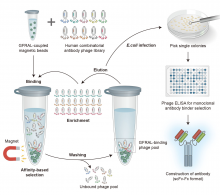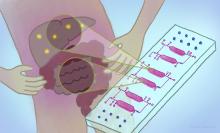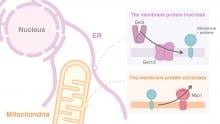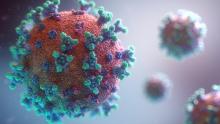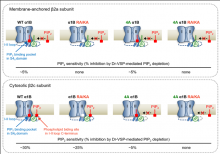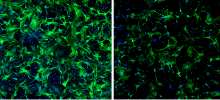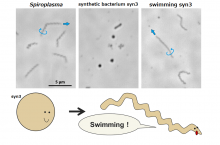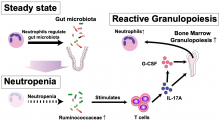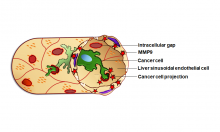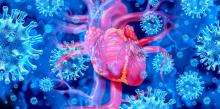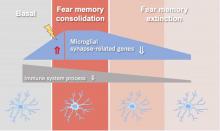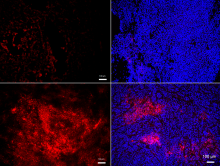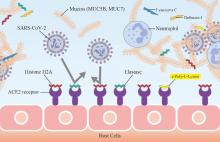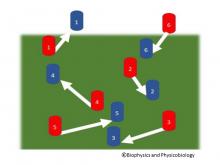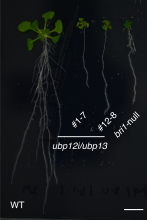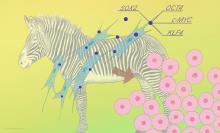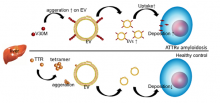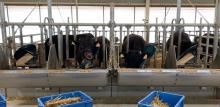Biology Cell biology
News
11 May 2023
A protein that helps bats survive viral diseases might offer lessons for developing new anti-inflammatory treatments.
11 May 2023
- In a groundbreaking study, Professor Yea’s DGIST research
team verified the effectiveness of the anti-GFRAL human
antibodies in improving chemotherapy-induced cancer cachexia
- The team presents a candidate antibody for managing cancer cachexia, a condition without an approved and effective
therapy worldwide
07 Apr 2023
A tiny platform empowers scientists to examine how gut and liver cells interact in health and disease.

12 Feb 2023
In hepatic steatosis, hepatocytes "die," resulting in liver damage. Severe steatosis increases hepatocellular deaths, thus aggravating liver damage. The mechanism is unclear. Using mice, we show that mild steatosis causes apoptosis whereas severe steatosis predominantly causes necroptosis leading to cell rupture. This induces strong inflammation and new cell death, producing further liver damage. We reveal the transcription factor ATF3 to be involved in this process. Our results are expected to contribute to therapeutic method development.
31 Jan 2023
Researchers from Osaka University have shown that a system known as the GET pathway is essential for efficient mitophagy, the process by which mitochondria are removed from cells. The GET pathway targets a protein assembly called the Ppg1–Far complex, which inhibits mitophagy, to the membrane of a part of the cell called the endoplasmic reticulum. When the GET pathway is defective, this complex instead becomes targeted to mitochondria, where it acts to suppress mitophagy.
19 Jan 2023
Researchers at Kanazawa University report in Nano Letters how high-speed atomic force microscopy can be used to assess the effectivity of spike-neutralizing antibodies for preventing COVID-19. The use of such antibodies offers a promising alternative to vaccines.
14 Dec 2022
- DGIST Professor Suh Byung-chang's research team identified the regulation mechanism of calcium channels, which are important for signal transmission between nerve cells
- A new clue to the development of substances for treating mental and neurological diseases
12 Dec 2022
Revelations about the mechanisms of two key proteins which maintain the asymmetric distribution of cholesterol within the cell membrane could help understand and treat diseases linked to its imbalance
09 Dec 2022
Silencing the gene, called WWP2, in patients in the early stages of cardiomyopathy could delay progression to heart failure by controlling immune cell infiltration and activation, and halting the formation of excessive scar tissue, preclinical data suggest.
30 Nov 2022
Osaka Metropolitan University researchers introduced seven proteins, thought to let bacteria swim by switching the direction that their helical bodies spiral, into a strain of synthetic bacterium with minimal genetic information. As a result, they confirmed that the synthetic bacterium named syn3, which is normally spherical, formed a helix that could swim by spiraling. Further investigation revealed that only two of these newly added proteins were required to make syn3 capable of minimal swimming. This swimming synthetic bacterium can be said to be the smallest mobile lifeform genetically, as it contains the fewest number of genes.
25 Nov 2022
A research group at the Osaka Metropolitan University Graduate School of Science has revealed a new system that allows them to control the behavior of the nematode worm Caenorhabditis elegans, using two different animal opsins, a type of light-sensitive protein. The first opsin was expressed in the worms’ sensory cells responsible for triggering avoidance behavior, making the worms move. This opsin was found to be approximately 7,000 times more sensitive to white light than the commonly used optogenetic protein channelrhodopsin-2. Likewise, a UV-sensitive opsin was expressed in the worms’ motor neurons, causing the worms to stop when exposed to UV light and start moving again when exposed to green light. Both opsins tested can be switched on and off repeatedly without breaking down, making them robust tools for future research, including the field of drug discovery.
21 Nov 2022
Intestinal bacteria composition is crucial to driving the recovery of neutrophils counts in the blood of mice following treatments such as stem cell transplants or chemotherapy.

14 Nov 2022
In a study recently published in the Journal of Extracellular Vesicles, researchers from Kanazawa University use high-speed microscopy to capture the dynamics of nanosized sacs released from cells.

08 Nov 2022
In a study recently published in the journal Nature Biomedical Engineering, researchers from Kanazawa University use a method called “lasso-grafting” to design therapeutics with enhanced longevity and brain penetration.

01 Nov 2022
6th NanoLSI Symposium: International symposium on Nanoprobe Technology for Understanding Molecular Systems in Kanazawa, Japan
25 Oct 2022
Small neighboring galaxy filled with dark matter detected with gamma rays, How a virus induces heart inflammation, Shedding light on the happy hormone, Microfossils may hold key evolution clues. Read all in the October's Editor's Choice plus Upcoming event KNOWLEDGE MARKETPLACE – Bangkok 2022: Exchanging of ideas for a Democratic Myanmar.
04 Oct 2022
Metastasis—when cancer spreads to form new tumors—causes approximately 90% of cancer-related deaths. Because metastatic cancer cells circulate in the blood, the liver—which filters the blood—is considered the most vulnerable organ, so treatments that prevent liver metastasis are urgently needed. A team of Osaka Metropolitan University researchers discovered a mechanism that allows metastatic cancer cells to infiltrate the liver, and how that infiltration can be blocked by inhibiting a related protein.
27 Sep 2022
Scientists have pinpointed a protein in lysosomes that is involved in recycling a crucial fatty component of cell membranes to keep cells healthy.
22 Sep 2022
A pathway that malfunctions in advanced non-alcoholic fatty liver disease could be fixed with the aid of spermidine, a compound naturally found in bodily cells and certain whole foods.
22 Sep 2022
Scientists have uncovered how Coxsackievirus B3, the most common cause for viral heart inflammation, takes advantage of a specific heart sensor to trigger chronic inflammation that can lead to heart failure.
12 Sep 2022
Microglia acts as the first line of defense in the central nervous system, constantly scanning for pathogens and abnormalities. Now, Tohoku University scientists have demonstrated that microglial genes associated with the synapse—structures that allow neurons to pass signals to one another—undergo changes in response to the brain processing traumatic memories.
26 Aug 2022
Researchers have made perovskite solar cells more efficient and stable, A new cause of Parkinson's related cell death, Hibernating superpower is in the blood, Common mechanism for cancer and atherosclerosis, COVID-19 antibody skin-based test. Read all in the August's Editor's Choice plus an Interview with Prof Sutee Yoksan on The story behind the new dengue vaccine & this month's Asia Research News 2022 magazine pick - The evolutionary history of puddle frogs.
23 Aug 2022
Two new approaches could help scientists use existing sequencing technology to better-distinguish RNA changes that affect how their genetic code is read.
25 Jul 2022
A key molecule for cancer metastasis has been identified as a molecule already known for its involvement in cardiovascular disease, suggesting a possible treatment approach for both diseases simultaneously.
19 Jul 2022
Saliva and oral cells are important routes for transmission and infection by the novel coronavirus COVID-19. A research group led by Associate Professor Misako Matsubara and Specially Appointed Professor Katsutoshi Yoshizato of Osaka Metropolitan University hypothesized that the body's innate immune system may protect against SARS-CoV-2 infection. The onset and severity of COVID-19 are age-dependent, as are parts of the innate immune system like saliva production and quality, which are significantly reduced in the elderly. They found that saliva from healthy individuals prevented the binding of the SARS-CoV-2 spike protein S1 on the viral envelope to the angiotensin-converting enzyme 2 (ACE2) receptor present on the plasma membrane of human cells in a concentration-dependent manner.
20 Jun 2022
Researchers at Kanazawa University report in Biophysics and Physicobiology how to optimize high-speed atomic force microscopy experiments on live cell membranes, so that moving objects like molecules can be properly followed from frame to frame.
03 Jun 2022
Scientists have revealed two enzymes that regulate protein degradation of proteins in the cell membrane of plants, and established the roles they play in plant growth and development.
25 Apr 2022
Examination of endangered species’ stem cells unveils ancient genetic links between mammals.
12 Apr 2022
Researchers at Kanazawa University elucidate in Frontiers in Molecular Biosciences how small biocontainers enclosed by membranes are involved in a disease called ATTRv amyloidosis.
31 Mar 2022
A collaborative research project has investigated the physiological changes in Japanese Black cattle during their unique feeding process, paving the way for evaluating their metabolic status and an even tastier cut of meat.
Events
Sorry, nothing coming up for this discipline
Researchers
Sorry, nothing coming up for this discipline
Giants in history
Sorry, nothing coming up for this discipline


